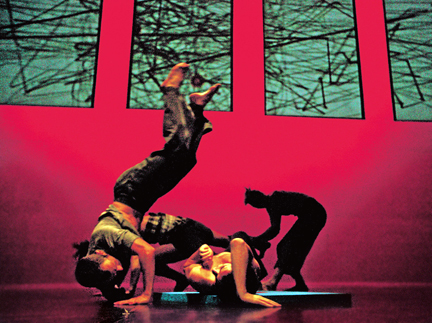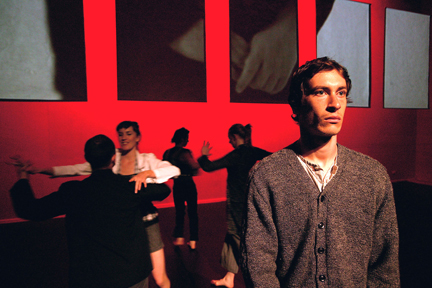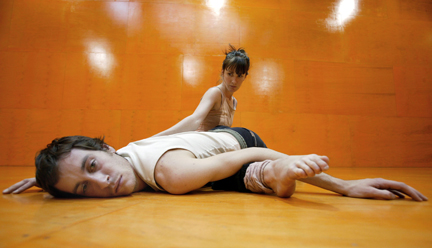Men's Studies
"I Want to Dance Better at Parties"
Chunky Move
The Joyce Theater
New York, NY
July 14, 2006
by Lisa Rinehart
copyright ©2006, Lisa Rinehart
 Chunky Move's director, Gideon Obarzanek, likes to tell stories, or, perhaps more accurately, he likes to tell us the stories behind the story. With "I Want to Dance Better at Parties," he's moved from the abstract darkness of last year's "Tense Dave" to a docudance exploring the importance of social dance in the lives of five Australian men. Projections of the men dancing — each in markedly different styles — float across five large suspended screens as the men tell us why they dance (or in one case, why they don't). One of the piece's six dancers (the excellent Kristy Ayre, Anthony Hamilton, Jo Lloyd, Lee Serle, Delia Silvan and Adam Wheeler) demonstrates a slicker version of the mens' moves and we quickly learn that our subjects are a diverse bunch. There's Philip, a recently widowed father with a curiosity about Latin dance, Jack, a retired engineer with a passion for Israeli dances, Dimosthenis, comfortable in the male milieu of Greek social dancing, Lindsay, a gay clog dancer, and Franc, a composer flummoxed by his inability to move. Obarzanek picks apart the facades of these not so average Joe's and shows us what we already suspect: everyone has a story to tell and it's usually quite different from what is articulated.
Chunky Move's director, Gideon Obarzanek, likes to tell stories, or, perhaps more accurately, he likes to tell us the stories behind the story. With "I Want to Dance Better at Parties," he's moved from the abstract darkness of last year's "Tense Dave" to a docudance exploring the importance of social dance in the lives of five Australian men. Projections of the men dancing — each in markedly different styles — float across five large suspended screens as the men tell us why they dance (or in one case, why they don't). One of the piece's six dancers (the excellent Kristy Ayre, Anthony Hamilton, Jo Lloyd, Lee Serle, Delia Silvan and Adam Wheeler) demonstrates a slicker version of the mens' moves and we quickly learn that our subjects are a diverse bunch. There's Philip, a recently widowed father with a curiosity about Latin dance, Jack, a retired engineer with a passion for Israeli dances, Dimosthenis, comfortable in the male milieu of Greek social dancing, Lindsay, a gay clog dancer, and Franc, a composer flummoxed by his inability to move. Obarzanek picks apart the facades of these not so average Joe's and shows us what we already suspect: everyone has a story to tell and it's usually quite different from what is articulated.
The beginning of the piece is the weakest as it circles in and around its subjects with the choppy pace of a documentary. There are protracted sequences of clogging (although one has to wonder if there's a style of dance the amazing Kristy Ayre hasn't mastered), and equally lengthy expositions of latin, folk and club dances that are amusing but tell us little about the men themselves. The work strengthens, however, as Oberzanek hones in on the mens' interior lives and the dancers take on what the subjects imply, but don't say. Philip, the widower, is responsible for the piece's title as he claims to have gone to a dance class so as to "learn how to dance better at parties." But as the dancers gingerly tip toe to the sucking sound of their own labored inhalations and exhalations, and we hear Philip describe panic attacks that leave him breathless, we realize he's paralyzed by grief. The dance class attended on a whim is a life preserver tossed into his sea of isolation and sadness, and the dancers are his psychological pain made manifest.
 Each man is similarly revealed by unexpected chunks of information delivered with calm detachment, and the dancers respond in ways sometimes funny and often violent. The agony of Franc, the self described clutz, is perfectly illustrated as one of the dancers contorts his face, lifts his shoulders and pulls at his crotch with the approach of a woman. At first, the self loathing seems about a fear of looking foolish in a social situation, but as the choreography gets rougher (and I mean rough — all the dancers wear knee pads and the partnering has the speed and brutality of martial arts) it's apparent that what Franc is really afraid of is sex, or, at least the vulnerability inherent in a sexual encounter.
Each man is similarly revealed by unexpected chunks of information delivered with calm detachment, and the dancers respond in ways sometimes funny and often violent. The agony of Franc, the self described clutz, is perfectly illustrated as one of the dancers contorts his face, lifts his shoulders and pulls at his crotch with the approach of a woman. At first, the self loathing seems about a fear of looking foolish in a social situation, but as the choreography gets rougher (and I mean rough — all the dancers wear knee pads and the partnering has the speed and brutality of martial arts) it's apparent that what Franc is really afraid of is sex, or, at least the vulnerability inherent in a sexual encounter.
Equally candid is Lindsay, the clogger recently dumped by his partner of ten years. He professes quietly to understanding the relationship wasn't working, but as he speaks two dancers throw themselves to the floor, jerking their bodies in tight, angry moves and blowing out air like bulls ready to charge. This sad-eyed, soft-voiced man is mad as hell.
 Obarzanek enjoys getting into the heads of these men and illustrating their emotions for us, but the best part of "I Want to Dance Better at Parties," is when Obarzanek hints at the idea that social dancing is, in fact, a means of transcendence. The Electric Slide as a spiritual exercise, you ask? Well... yes. Obarzanek cranks up the volume and the dancers go into a slam fest as they hurl themselves one after another onto a piece of foam marked with an X. A single dancer comes forward and curls herself into a sinuous silhouette as the others rave behind her. It is loud and extreme and exhilarating, and we understand that dance, even mild mannered social dance, allows primal impulses to surface and that that experience is, in fact, a kind of freedom.
Obarzanek enjoys getting into the heads of these men and illustrating their emotions for us, but the best part of "I Want to Dance Better at Parties," is when Obarzanek hints at the idea that social dancing is, in fact, a means of transcendence. The Electric Slide as a spiritual exercise, you ask? Well... yes. Obarzanek cranks up the volume and the dancers go into a slam fest as they hurl themselves one after another onto a piece of foam marked with an X. A single dancer comes forward and curls herself into a sinuous silhouette as the others rave behind her. It is loud and extreme and exhilarating, and we understand that dance, even mild mannered social dance, allows primal impulses to surface and that that experience is, in fact, a kind of freedom.
Obarzanek's Chunky Move is a rare combination of expert dancers, sophisticated visuals and the use of movement to explore psychological terrain. And while this piece could have used some editing, Obarzanek's ability to look into the grisly innards of emotion and translate what he finds into choreography is undeniable. I look forward to whatever snake pit he chooses to show us next.
All photos by Igor Sapina.
Volume 4, No. 27
July 17, 2006
copyright ©2006 Lisa Rinehart
www.danceviewtimes.com